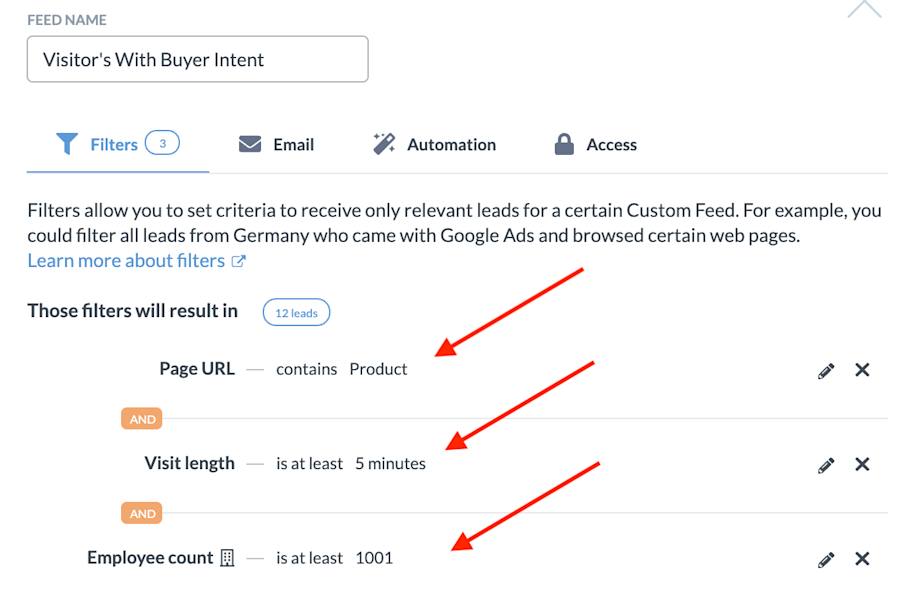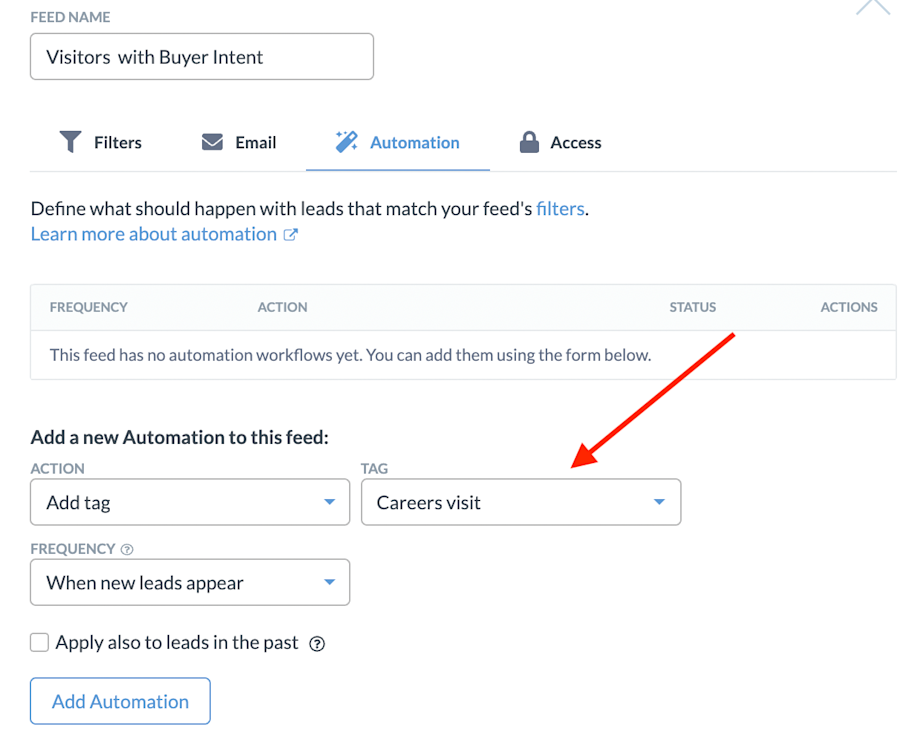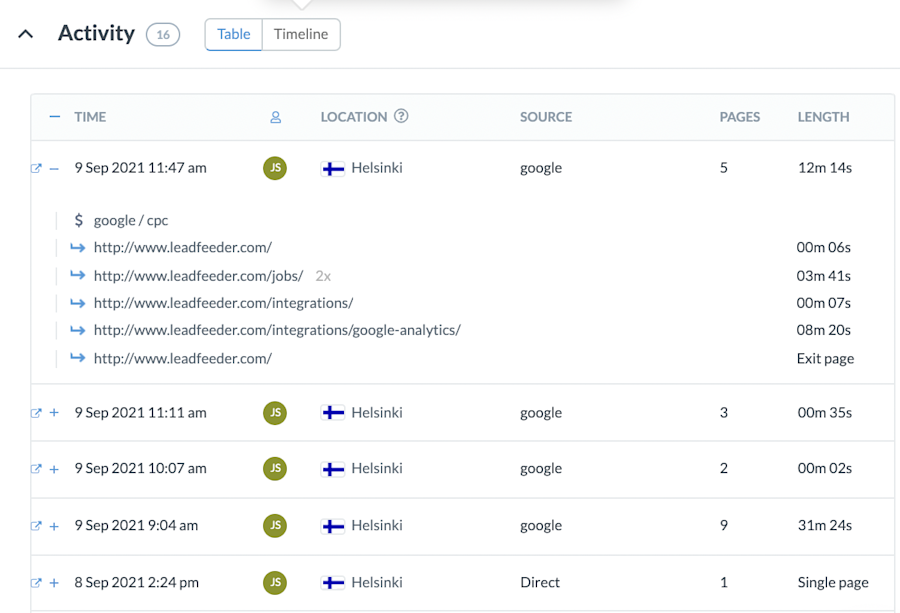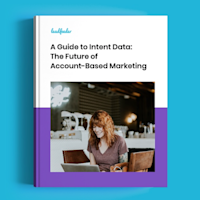Marketing is getting harder for B2B companies. The sales cycle is getting longer, with the average B2B sales cycle taking 102 days. Yikes.
Even users that download a lead magnet or fill out a contact form might not be ready to buy. Targeting them too early could waste time (and ad spend).
Or, you might end up targeting leads that aren't even in your target audience.
How do you avoid wasting time and budget? There's secret data on your website you might be ignoring — buyer intent data.
You might not be new to buyer intent data, but there's a good chance you're missing some strong intent signals hidden right on your website. Wanna learn more? Keep reading. 👇
Note: Leadfeeder is the buyer intent data tool you've been waiting for. Sign up for a free trial, install our tracker, and we'll start sending you buyer intent data today.
What is B2B intent data?
Buyer intent data refers to actions that indicate a specific prospect or site visitor is interested in making a purchase.
They aren't researching their options or just looking for blog posts — they know what they need and are almost ready to buy.
Buyer intent data is specific signals users send that tell you they’re ready for your sales or marketing team to step in and close the deal.
Requesting a demo or signing up for a trial are the most obvious examples of buyer intent.
Depending on your industry and marketing models, many other actions can be intent signals, for example:
Visiting your pricing page after ready two to three blog posts
Downloading a pricing comparison guide
Using site search to search "free trial" or "demo"
How intent data works
Intent data has two essential parameters: WHO is doing the action, and WHAT that action is.
When both of these line up with your own definition of buyer intent, then you have a solid prospect.
Here's an example of why the who and the what matters: Say two visitors take the same action — they visit your pricing page.
Are they both ready to buy? Maybe.
Say one visitor is in your target audience and has read three blog posts in the last two days.
They are likely ready to buy.
But based on IP address, you can tell the other visitor works for your main competitor.
It's pretty clear the competitor isn't going to make a purchase; they're probably looking to see how much you charge.
Remember, how you define an intent signal (meaning a signal someone is ready to buy) can vary based on your industry, market, and the length of your sales funnel.
Defining intent signals for your business is crucial to using buyer intent data.
How to use buyer intent data in B2B marketing
Online behavior, such as what content visitors consume or what campaigns they engage with, provides clues about where they are in the buying cycle.
How can you use that data to improve your marketing?
Here are a few ways buyer intent data can turn you into a marketing superhero.
Filter out unqualified leads
Tired of wasting time on leads that aren't ready to buy?
Tracking buyer intent data helps filter out companies that don’t fit your target personas or reach a minimum level of engagement.
For example, someone might hit the right engagement level but live in a country you don't service.
In Leadfeeder, you can create Custom Feeds that take care of lead scoring for you, automatically filtering out companies that don’t fit your target personas or reach a minimum level of engagement.

Once a lead comes through your feed, you can further qualify them using automation Leadfeeder’s Custom Feeds.
For example, someone may visit your product page — but if they also visit your jobs or careers page, chances are, they don’t have buying intent.
You can use automation to filter those leads out:

Inform your content marketing efforts
If you’re interested in switching software or finding a new vendor, you’re probably going to ask around or – more likely – go straight to Google for a little recon work.
Buyer intent data from your website can tell you what blog posts buyers read before they leave, what case studies are most likely to result in a conversion, even how many pages buyers usually visit before conversion.
That information can give you insight into the types of content your buyers are interested in so you can create more of it — ultimately increasing conversions.
Pull more insights from outreach campaigns
The average cold email campaign gets less than a one percent response rate.
But, that’s not the end of the story — at least it doesn’t have to be.
If you’re leveraging the right buyer intent software, you can still gain valuable insights into how prospects behave upon receiving your email.
For instance, software like Mailshake can track key campaign metrics like email open rates and click monitoring so you can see what subject lines or content is relevant to specific stages in the buyer’s journey.
When users reply, you can trigger automated follow-up emails using pre-made templates designed to further identify their buyer’s intent and assign them a lead score.
Leverage machine learning and AI
To stay ahead of the digital natives, B2B companies need to be where the consumers are – anytime, anywhere.
Chat solutions like Intercom are easy to install, relatively affordable, and start directing traffic and gathering buyer intent right away.
You can opt to use live chat to provide a personal experience or automate the process with an Intercom chatbot that welcomes users, asks questions, and then routes them to the appropriate sales team when they are ready to buy.
Personalize your marketing efforts
Marketing personalization isn't just a buzzword — it's an incredibly effective strategy that helps businesses deliver exactly what consumers want.
In fact, 80 percent of customers are more likely to buy when brands offer personalized experiences.
Buyer intent data can inform your personalization efforts.
Say a company came to your site through a Mailchimp email campaign about a new product or service.
You can ensure your outreach messaging corresponds to that email copy and landing pages.
Here’s another example: If a lead visited your CRM Integrations page, they’re likely interested in whether or not your product works with their favored CRM.
You can include that information in your sales pitch to make it more relevant to the things that particular lead cares about.
How to collect and use B2B buyer intent data
Google Analytics can tell you how many people visit a particular page, whether they came from social media or your blog, how long the average visitor spends on your site, and even how many conversions you can attribute to a specific page.
That’s all useful information.
But it doesn’t help you identify, target, or convert B2B leads.
It doesn’t help you personalize and tailor your marketing efforts throughout the buyer’s journey.
And it doesn’t offer any firmographic details.
Instead, B2B marketers and salespeople need a buyer intent software option like Leadfeeder that identifies site visitors (that's the WHO) and tracks onsite behavior (the WHAT part of intent data.)
There are a range of buyer intent data tools that can help you do just that.
Leadfeeder allows you to see who visits your website and provides data on the organization that's visiting your website.
You can see who is the best contact at that company, including their email and social profiles.
In addition, Leadfeeder tells you what pages they've browsed. For example, you can see they spent four minutes watching a video or one minute on your pricing page.
You can even see what page they exited on:

That's valuable intent data you can use to improve your marketing campaigns or pass on to sales.
You don’t have to stop there — you can add additional data points about demographics or the behavior of trial users in your product.
Using Zapier or a similar tool, you can collect all this data into one place—usually your CRM—and use it further.
You can also use Leadfeeder to qualify leads by using custom feeds, as I covered in the section above.
For each Custom Feed, you can choose people to notify when new sales leads arrive — and you can notify them via email, Slack notification, or both.
You can also connect Leadfeeder with your CRM software to automatically push new leads into your CRM and assign it to the appropriate salesperson.
Once the right team members are notified about a new target account, they can head into Leadfeeder directly to get more details to inform their outreach.
For example, if the visit details show that a company visited a particular service page on your website, that gives sales reps insight into what department of the company to reach out to or what solutions they are looking for.
B2B buyer intent data is key to a more effective marketing strategy
From qualifying leads to building more effective nurture campaigns, buyer intent data helps B2B businesses target leads more effectively, understand what target accounts want, and create more personalized messaging that drives higher conversion rates.
Using a buyer intent tool like Leadfeeder is the key to unlocking B2B intent data hiding on your website and put that data to work in your marketing efforts.
Note: Ready to pull buyer intent data from your website? Sign up and try Leadfeeder free for 14 days.
Now that you're here
Leadfeeder is a tool that shows you companies that visit your website. Leadfeeder generates new leads, offers insight on your customers and can help you increase your marketing ROI.
If you liked this blog post, you'll probably love Leadfeeder, too.
Sign up








